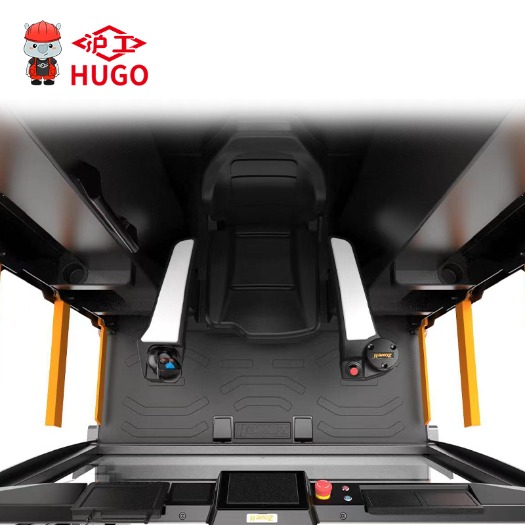
- English
- Español
- Português
- русский
- Français
- 日本語
- Deutsch
- tiếng Việt
- Italiano
- Nederlands
- ภาษาไทย
- Polski
- 한국어
- Svenska
- magyar
- Malay
- বাংলা ভাষার
- Dansk
- Suomi
- हिन्दी
- Pilipino
- Türkçe
- Gaeilge
- العربية
- Indonesia
- Norsk
- تمل
- český
- ελληνικά
- український
- Javanese
- فارسی
- தமிழ்
- తెలుగు
- नेपाली
- Burmese
- български
- ລາວ
- Latine
- Қазақша
- Euskal
- Azərbaycan
- Slovenský jazyk
- Македонски
- Lietuvos
- Eesti Keel
- Română
- Slovenski
- मराठी
- Srpski језик
What is an Electric Stacker and How Does It Work?
2024-09-23

What are the different types of electric stackers available in the market?
There are mainly two types of electric stackers available in the market - pedestrian stackers, and ride-on stackers. The pedestrian stackers are compact, lightweight, and easy-to-use machines, ideal for small-scale operations. On the other hand, the ride-on stackers are more sturdy, efficient, and designed for heavy-duty operations.What are the key features of an electric stacker?
The key features of an electric stacker include its lifting capacity, lifting height, load center, fork length, and overall machine dimensions. In addition, electric stackers have ergonomic features such as adjustable seats, armrests, and panel controls, making them more user-friendly and comfortable.How does an electric stacker differ from a forklift?
The primary difference between an electric stacker and a forklift is their lifting capacity and maneuverability. Electric stackers are designed for lighter loads and restricted spaces, while forklifts are made for heavier loads and wider spaces. Electric stackers are also comparatively compact and easy-to-maneuver, providing a high degree of precision and control.What are the maintenance requirements for an electric stacker?
To ensure the optimal performance and longevity of an electric stacker, it's essential to keep it well-maintained. Regular maintenance includes checking the fluid levels, cleaning the machine, and inspecting the parts for any damage. It's also crucial to get the electric stacker serviced by a qualified professional regularly.Electric stackers have become increasingly popular in the material handling industry for their efficiency, reliability, and user-friendliness. They offer an affordable and safe alternative to traditional heavy equipment and are suitable for a wide range of applications. Whether you need to move goods around a warehouse or load and unload trucks, electric stackers can help streamline your operations and boost productivity.
Shanghai Yiying Crane Machinery Co., Ltd. is a leading manufacturer and supplier of electric stackers in China. We provide a range of high-quality electric stackers that are designed for different material handling applications. Our machines are built to last, easy-to-use, and come with excellent after-sales support. Contact us at sales3@yiyinggroup.com to learn more about our products and services.
Research Papers:
1. Ahmad, T., & Hassan, M. U. (2019). Modeling and simulation of hydraulic system of forklift truck for optimized hydraulic circuits. Journal of the Brazilian Society of Mechanical Sciences and Engineering, 41(4), 167.
2. Kamasz, M., Ficzere, Z., Gál, L., & Viharos, Z. J. (2017). Key technologies of intelligent logistics and robotized forklift. Procedia Engineering, 182, 372-379.
3. Jahan, M. P., Rashid, M. A., & Alam, M. M. (2019). Performance optimization of a forklift transmission using a genetic algorithm. International Journal of Automotive and Mechanical Engineering, 16(1), 6236-6247.
4. Göktepe, A. B. (2018). Determination of fuel consumption and exhaust emissions of a counterbalanced forklift truck in a medium-sized warehouse. International Journal of Sustainable Energy, 37(1), 87-98.
5. Zhang, Y., & Huang, Y. (2017). An Exact Feedback Linearizing Control Strategy for an Electric Forklift Vehicle. IEEE Transactions on Industrial Informatics, 13(2), 1079-1089.
6. Liu, Z. Y., Wang, S. J., Li, W., & Li, M. Q. (2018). A collision detection system for forklift trucks using a three-dimensional laser scanner. Measurement, 122, 136-146.
7. Kara, M. E., Kizilkaya, İ., & Dönmez, M. A. (2019). Utilization of Automated Guided Vehicles in Flexible Manufacturing: A Case Study on AGV/Forklift Hybrid System. Procedia Manufacturing, 30, 98-103.
8. Campelo, F. (2019). Predictive maintenance: a case study of an industrial forklift. Journal of Ambient Intelligence and Humanized Computing, 10(2), 545-555.
9. Yang, J., & Wang, L. (2020). A Novel Hybrid Powertrain System Based on Compound Structure for Electric Forklift Trucks. IEEE Transactions on Industrial Electronics, 67(3), 2111-2121.
10. Stawiński, L. R. (2017). Energy consumption analysis of a reach truck during standard handling operations using simulation model. International Journal of Occupational Safety and Ergonomics, 23(2), 276-282.


